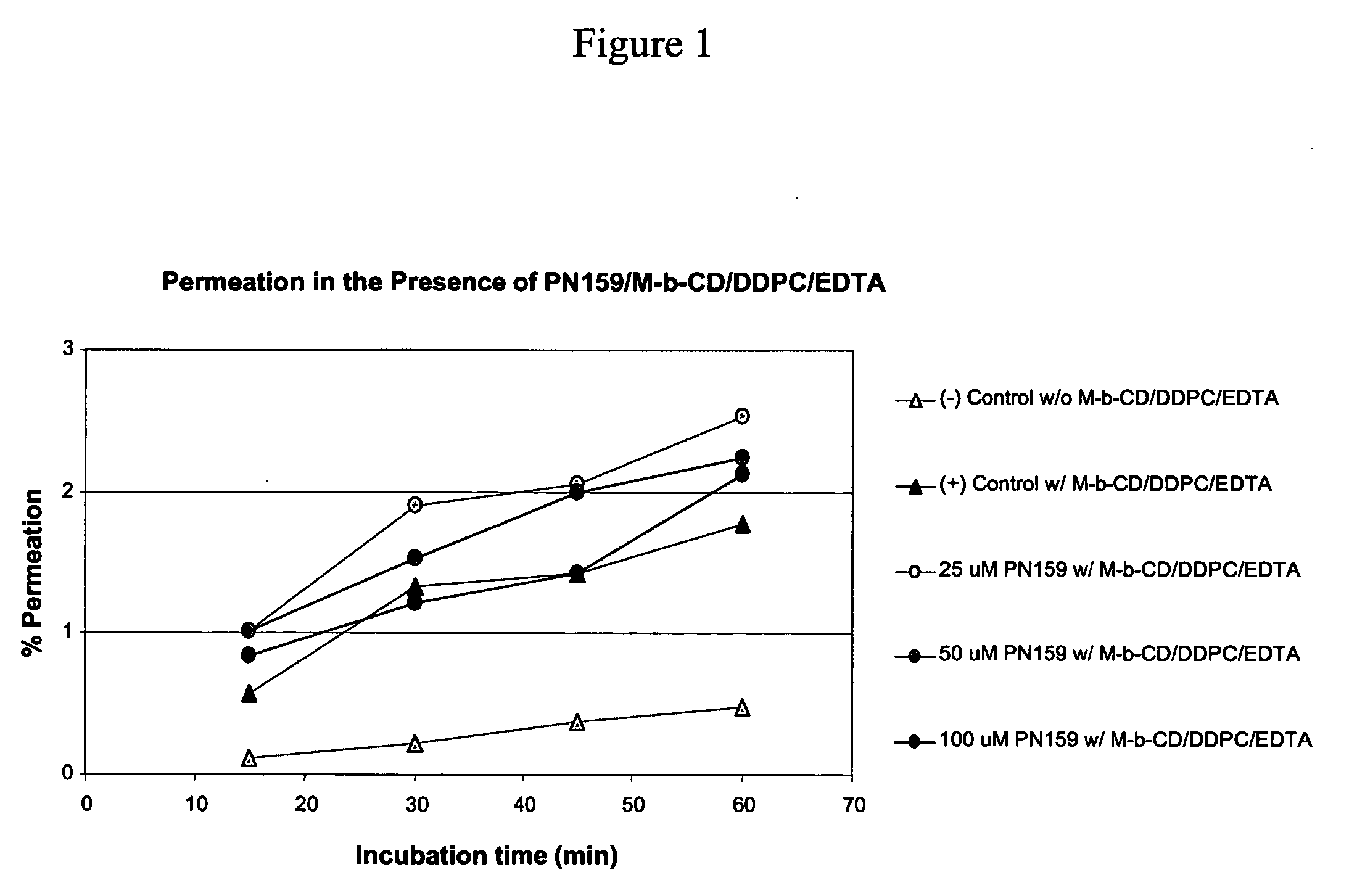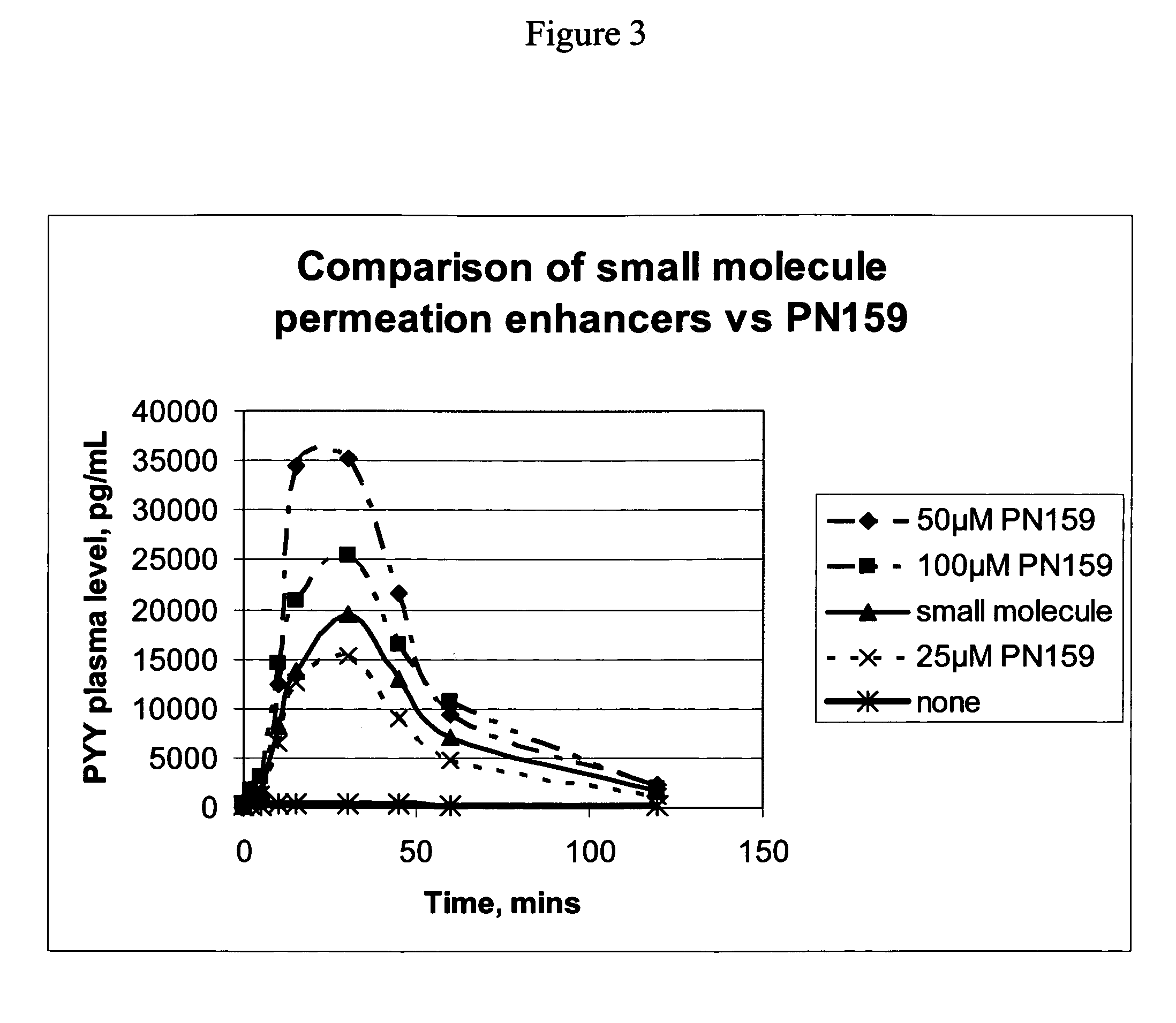Tight junction modulator peptide PN159 for enhanced mucosal delivery of therapeutic compounds
a technology of tight junction and modulator peptide, which is applied in the direction of extracellular fluid disorder, immunological disorder, metabolism disorder, etc., can solve the problems of increased risk of infection, many patients are reluctant or unable to give themselves injections on a regular basis, and trained personnel are often required to administer drugs, etc., to achieve low cytotoxicity, reduce transepithelial electrical resistance (ter), and increase paracellular transport
- Summary
- Abstract
- Description
- Claims
- Application Information
AI Technical Summary
Benefits of technology
Problems solved by technology
Method used
Image
Examples
example 1
Mucosal Delivery—Permeation Kinetics and Cytotoxicity Organotypic Model
[0105] The following methods are generally useful for evaluating mucosal delivery parameters, kinetics and side effects for a biologically active therapeutic agent and a mucosal delivery-enhancing effective amount of a permeabilizing peptide that reversibly enhances mucosal epithelial paracellular transport by modulating epithelial junctional structure and / or physiology in a mammalian subject.
[0106] The EpiAirway™ system was developed by MatTek Corp (Ashland, Mass.) as a model of the pseudostratified epithelium lining the respiratory tract. The epithelial cells are grown on porous membrane-bottomed cell culture inserts at an air-liquid interface, which results in differentiation of the cells to a highly polarized morphology. The apical surface is ciliated with a microvillous ultrastructure and the epithelium produces mucus (the presence of mucin has been confirmed by immunoblotting). The inserts have a diameter...
example 2
Epithelial Permeation Enhancement by PN159
[0133] The examples herein below demonstrate that permeation enhancing peptides of the invention, exemplified by PN159, enhance mucosal permeation to peptide therapeutic drugs, including PTH and Peptide YY. This permeation enhancing activity of the peptides of the invention, as evinced for PN159, can be equivalent to, or greater than, epithelial permeation enhancement achieved through the use of one or multiple small molecule permeation enhancers.
[0134] Peptide YY3-36 (PYY3-36) is a 34 amino acid peptide which has been the subject of numerous clinical trials. Mucosal delivery of this biologically active peptide can be enhanced in formulations that include small molecule permeation enhancers. Accordingly, the instant studies assessed whether the permeation enhancing peptides of the invention, exemplified by PN159, could replace the role of small molecule permeation enhancers to facilitate mucosal delivery of peptide YY. These studies includ...
example 3
In Vivo Permeation Enhancement by PN159 for a Peptide Hormone Therapeutic Agent Equals or Exceeds that of Small Molecule Permeation Enhancers
[0143] 20 male New Zealand White rabbits age 3-6 months and weighing 2.1-3.0 kg were randomly assigned into one of 5 treatment groups with four animals per group. Test animals were dosed at 15 μl / kg and intranasally via pipette. Table 4 below indicates the composition of five different dose groups.
[0144] For dosing group 1 (see Table 1) a clinical formulation of PYY including small molecule permeation enhancers was used. The small molecule enhancers in these studies included methyl-βcyclodextrin, phosphatidylcholine didecanoyl (DDPC), and / or EDTA. Dosing group 2 received PYY dissolved in phosphate buffered saline (PBS). For dosing groups 3-5, various concentrations of PN 159 were added to dosing group 2, so that each of dosing groups 3-5 consisted of PYY, PN159, and PBS.
TABLE 1DosePYYConcDose VolDoseGroupAnimalsPermeation enhancers(mg / ml)(m...
PUM
| Property | Measurement | Unit |
|---|---|---|
| radii | aaaaa | aaaaa |
| surface area | aaaaa | aaaaa |
| diameter | aaaaa | aaaaa |
Abstract
Description
Claims
Application Information
 Login to View More
Login to View More - R&D
- Intellectual Property
- Life Sciences
- Materials
- Tech Scout
- Unparalleled Data Quality
- Higher Quality Content
- 60% Fewer Hallucinations
Browse by: Latest US Patents, China's latest patents, Technical Efficacy Thesaurus, Application Domain, Technology Topic, Popular Technical Reports.
© 2025 PatSnap. All rights reserved.Legal|Privacy policy|Modern Slavery Act Transparency Statement|Sitemap|About US| Contact US: help@patsnap.com



